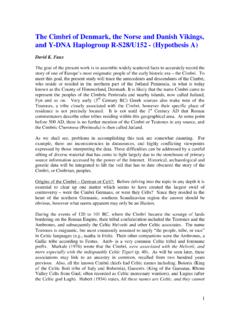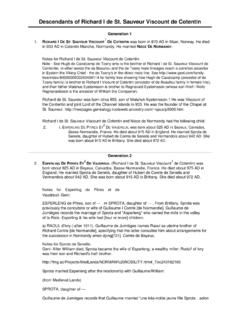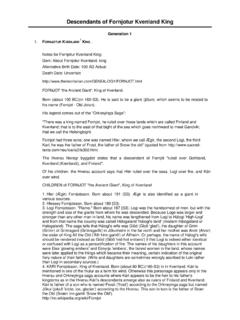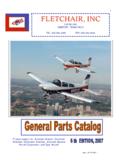Transcription of Y-Chromosome Marker S28 / U152 Haplogroup R-U152 …
1 Y-Chromosome Marker S28 / u152 . Haplogroup R-U152 . Resource Page David K. Faux To use this page as a resource tool, click on the blue highlighted words, which will take the reader to a relevant link. How was this Marker discovered? In 2005 Hinds et al. published a paper outlining the discovery of almost million SNPs in 71 Americans by , and which were deposited in the online dbSNP database. Gareth Henson noticed three SNPs that appeared to be associated with M269, what was then known as Haplogroup R1b1c. Dr. James F. Wilson of EthnoAncestry developed primers for these Single Nucleotide Polymorphism (SNP) markers on the Y-Chromosome , one of which was given the name of S28 (part of the S-series of SNPs developed by Dr. Wilson). Who were the first to be identified with this SNP? In testing the DNA of a number of R- M269 males (customers or officers of EthnoAncestry), two were found to be positive for S28 ( u152 ).
2 These were Charles Kerchner (of German descent) and David K. Faux, co- founder of EthnoAncestry (of English descent). How is this Marker classified? In 2006 the International Society of Genetic Genealogists (ISOGG) developed a phylogenetic tree since the academic grouping (the Y. chromosome Consortium YCC) set up to do this task had lapsed in 2002. They determined, with the assistance of Dr. Wilson, that the proper placement would be R1b1c10, in other words downstream of M269 the defining Marker for R1b1c. Karafet et al. (2008) (including Dr. Michael Hammer of the original YCC group) published a new phylogenetic tree in the journal Genome Research. The designation for S28 / u152 . became R1b1b2h*. Recently a group of genetic genealogists, using findings from the 23andME testing, discovered a SNP between M269 and S28 / u152 , called S116 by EthnoAncestry, and P312 by the Hammer group (YCC), which caused ISOGG to revise their phylogenetic tree.
3 The most up to date classification for the YCC is Karafet et al. (2008) Errata. Presently Family Tree DNA has termed u152 + as R1b1b2a1b4, if L2/S139+ add a c and if also L20/S144+ add a 1 . ISOGG (2009) has the category as R1b1b2a1a2d, and with L2/S139+ add a 3 and if L20/S144+ add an a . Perhaps the most sensible or parsimonious designation is R-U152 for most purposes. What is the general nature of the S28 / u152 mutation? S28 is a neutral transition mutation (it does not adversely affect the functioning of any known gene) where an ancestral Guanine was replaced by the derived Adenine at a single location on the Y- 1. chromosome . The event presumably happened only once in the history of mankind. Thus some thousands of years ago a spot mutation occurred during meiosis in an R- P312* father. The mutation was passed to his son who in turn passed it on to every one of his descendants in the direct male line.
4 Thus all R-U152 males have the same ancestor in the Y-line, although the age of the mutation (when S28 / u152 first appeared) has not been determined. How old is the mutation? There is no molecular clock which will provide an absolute dating such as dendochronology (tree ring dating). The date depends on a host of assumptions such as generation age, whether to consider back mutations, accepting a mutation rate and so on. Robert McGregor used the Zhivotovsky et al. (2006) approach and obtained a date for the Most Recent Common Ancestor of 11,400 years (plus or minus 1000 years) of all those in the author's database. Vince Vizachero has estimated the age of S28 as 6600 years (Neolithic), and Dr. Ken Nordtvedt has obtained a date of about 3700 years (Bronze Age). While due consideration must be given these estimates, it is highly likely that what is being detected is an expansion of this Haplogroup , whereas its origin lies in the Mesolithic, about 10,000 years ago.
5 Thus the present author is inclined to accept the McGregor estimate since it accords best with all other data sources. Ultimately only ancient DNA samples are going to settle the matter to everyone's satisfaction. What are some of the technical aspects of the S28 / u152 SNP? The essential facts can best be expressed in chart form: Marker Rs # Forward PCR primer Reverse PCR primer Product Size SNP position (bp). (5'-3') (5'-3') (bp). u152 rs1236440: G>A cttagctatacagcctctttttgg aacattccacgcttgaggataa 172 127. What does the G to A mutation of a male who is S28 / u152 + look like along the sequence of base pairs in the vicinity of the Marker ? This can best be viewed by a pherogram / chromatogram printout from the program Sequencher to see the difference between an ancestral and derived Y-Chromosome at this location. Where on the Y-Chromosome is the S28 / u152 mutation?
6 This Marker can be viewed via the Y-Chromosome browser created by Thomas Krahn. Is there any way to relate S28 / u152 to the broad east west classification system for R-M269? There appears to be an important division between the most common forms of R-M269 from Bulgaria eastward versus westward. An old fashioned Marker that is seldom used in studies today is the p49a,f Taq haplotype system. Cinnioglu et al. (2004). used this in describing their samples from locations such as Turkey and Armenia and those from Iberia and other locations in western Europe. The division is dramatic, Haplotype 35 is characterisitic of most R-M269 east of the Balkans, whereas Haplotype 15 is most common in western Europe. Unfortunately no company at present will do commercial testing for this Marker , but Vincent Vizachero has found a set of markers that can act as surrogates.
7 The evidence is very clear, if someone has DYS393=12, DYS461=11, and DYF385=9,10 or 10,10 then it would appear that they are of the 2. Eastern Haplotype 35 variety. Similarly the motif characteristic of Haplotype 15 or Western variety is DYS393=13, DYS461=12, and DYF385=10,11. All R-U152 that have been tested for these markers fit into the latter pattern and hence are of the Western variety of R-M269 which according to Cinnioglu et al. (2004) likely expanded out of the Franco-Cantabrian refugium after the Last Glacial Maximum (whereas the Eastern type likely expanded from the West Asian area at this time). How does the new SNP found via deCODEme testing, known as S116 / P312, relate to S28 / u152 ? Recent testing by Thomas Krahn at FTDNA has revealed that that R-U152 , R-M153, R-M167, R-M222 and some R-M269* test positive for S116 / P312, meaning they have the derived A allele; whereas those who are R-U106 plus all Eastern R-M269*.
8 Should have the ancestral C allele on this Marker . This will perhaps link in a broad sweeping way those whose ancestors belonged to a Celtic culture (Insular or Continental). who will all share the S116 / P312+ polymorphism, dividing them from the S21 / R-U106. Germanic group as well as the large group of R-M269* Eastern found from Bulgaria to Kazakhstan and Anatolia. Why is S28 also known by another name u152 ? In 2007 Sims et al. published a paper in Human Mutation which identified the markers developed by Dr. Wilson, but using new names. Hence S28 is comparable to u152 in their paper. Which companies test S28 / u152 ? From April of 2005 until February 2008 only EthnoAncestry offered this SNP. Presently Family Tree DNA tests the markers developed by Dr. Wilson, which they call the U-series or the Garvey Panel , which includes what they termed u152 (using the Sims et al.)
9 2007 classification). This testing is only available to those who have tested at least 12 Y-STR markers (the standard Y- chromosome test in genetic genealogy) with FTDNA. Presently deCODEme and 23andME also test this Marker and the latter also tests for L2/S139 and L20/S144 (see later). What do the certificates look like? Click for examples of EthnoAncestry's and FTDNA's certificates attesting to a positive finding for S28 and u152 respectively. What databases are available for S28 / u152 ? Soon after S28 was identified David K. Faux began collecting haplotypes and genealogical information (particularly the place of birth of the earliest known ancestor in the Y-line). He also included research testing of his Shetland Islands samples, as well as some as yet unpublished data from academic research. Data is screened to ensure that, particularly in the case of those who are of Colonial American ancestry in the Y-line, that they have a solid paper trail lineage back to a European country.
10 The data includes those tested at EthnoAncetry and FTDNA (and any other company who will offer this testing). In March 2008 it was announced that Charles Kerchner would be administering a FTDNA sponsored R-U152 project. It is only open to those who have SNP tested u152 + at FTDNA. Recently Tibor Fejer assumed the role of co-administrator and succeeded in clustering all of the meaningful groups within u152 together ( , a separate category for those who are R-U152 * with DYS492=12. and another for those who have 14 repeats at his Marker ). Adriano Squecco is collecting 3. all of the raw data from individuals who test with deCODEme and 23andME (Versions 1. and 2) and has presented in a spreadsheet database. In addition, Ysearch includes those who are identified as S28 or u152 and chose to include their data in this database. At present the database appears to be in the process of shifting from the R1b1b2h to the current FTDNA designation, but much data seems to have vanished in the process (hopefully this will be corrected shortly).











